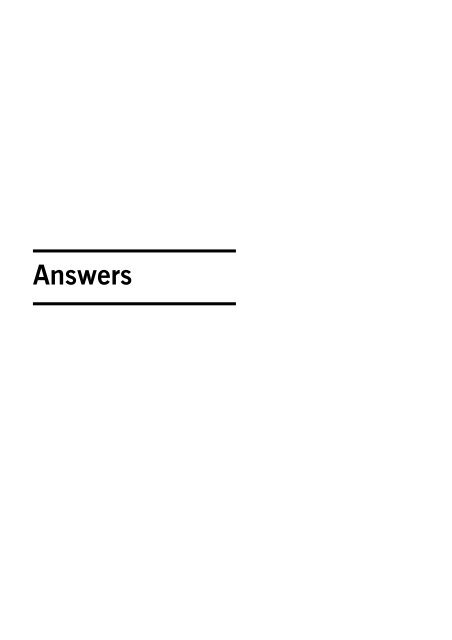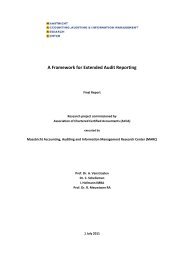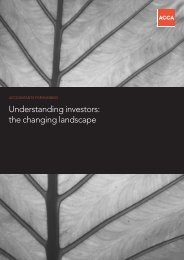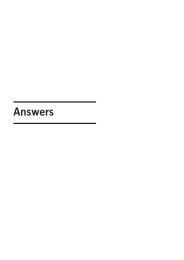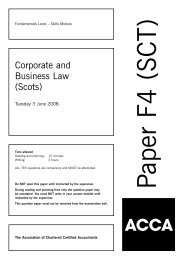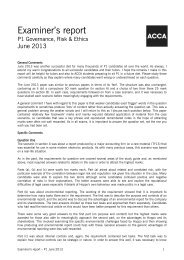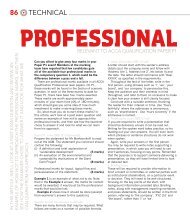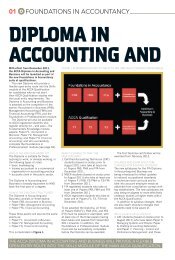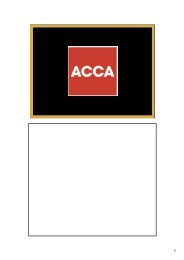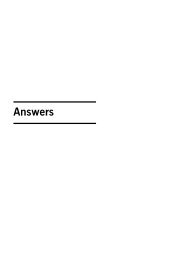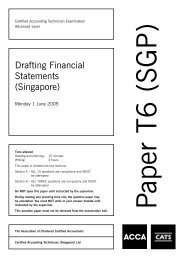Answers - ACCA
Answers - ACCA
Answers - ACCA
You also want an ePaper? Increase the reach of your titles
YUMPU automatically turns print PDFs into web optimized ePapers that Google loves.
<strong>Answers</strong>
Fundamentals Level – Skills Module, Paper F9<br />
Financial Management<br />
June 2008 <strong>Answers</strong><br />
1 (a) Calculation of weighted average cost of capital (WACC)<br />
Cost of equity<br />
Cost of equity using capital asset pricing model = 4·7 + (1·2 x 6·5) = 12·5%<br />
Cost of convertible debt<br />
Annual after-tax interest payment = 7 x (1 – 0·3) = $4·90 per bond<br />
Share price in six years’ time = 5·50 x 1·06 6 = $7·80<br />
Conversion value = 7·80 x 15 = $117·00 per bond<br />
Conversion appears likely, since the conversion value is much greater than par value.<br />
The future cash flows to be discounted are therefore six years of after-tax interest payments and the conversion value received<br />
in year 6:<br />
Year Cash flow $ 10% DF PV ($) 5% DF PV ($)<br />
0 market value (107·11) 1·000 (107·11) 1·000 (107·11)<br />
1–6 interest 4·9 4·355 21·34 5·076 24·87<br />
6 conversion 117·00 0·564 66·00<br />
–––––––<br />
0·746 87·28<br />
––––––––<br />
(19·77)<br />
–––––––<br />
5·04<br />
––––––––<br />
Using linear interpolation, after-tax cost of debt = 5 + [(5 x 5·04)/(5·04 + 19·77)] = 6·0%.<br />
(Note that other after-tax costs of debt will arise if different discount rates are used in the linear interpolation calculation.)<br />
We can confirm that conversion is likely and implied by the current market price of $107·11 by noting that the floor value of<br />
the convertible debt at an after-tax cost of debt of 6% is $93·13 (4·9 x 6·210 + 100 x 0·627).<br />
Cost of bank loan<br />
After-tax interest rate = 8 x (1 – 0·3) = 5·6%<br />
This can be used as the cost of debt for the bank loan.<br />
An alternative would be to use the after-tax cost of debt of ordinary (e.g. not convertible) traded debt, but that is not available<br />
here.<br />
Market values<br />
Market value of equity = 20m x 5·50 = $110 million<br />
Market value of convertible debt = 29m x 107·11/100 = $31·06 million<br />
Book value of bank loan = $2m<br />
Total market value = 110 + 31·06 + 2 = $143·06 million<br />
WACC = [(12·5 x 110) + (6·0 x 31·06) + (5·6 x 2)]/143·06 = 11·0%<br />
(b)<br />
(c)<br />
The weighted average cost of capital (WACC) can be used as a discount rate in investment appraisal provided that the risks<br />
of the investment project being evaluated are similar to the current risks of the investing company. The WACC would then<br />
reflect these risks and represent the average return required as compensation for these risks.<br />
WACC can be used in investment appraisal provided that the business risk of the proposed investment is similar to the<br />
business risk of existing operations. Essentially this means that WACC can be used to evaluate an expansion of existing<br />
business. If the business risk of the investment project is different from the business risk of existing operations, a projectspecific<br />
discount rate that reflects the business risk of the investment project should be considered. The capital asset pricing<br />
model (CAPM) can be used to derive such a project-specific discount rate.<br />
WACC can be used in investment appraisal provided that the financial risk of the proposed investment is similar to the<br />
financial risk of existing operations. This means that financing for the project should be raised in proportions that broadly<br />
preserve the capital structure of the investing company. If this is not the case, an investment appraisal method called adjusted<br />
present value (APV) should be used. Alternatively, the CAPM-derived project-specific cost of capital can be adjusted to reflect<br />
the financial risk of the project financing.<br />
A third constraint on using WACC in investment appraisal is that the proposed investment should be small in comparison with<br />
the size of the company. If this were not the case, the scale of the investment project could cause a change to occur in the<br />
perceived risk of the investing company, making the existing WACC an inappropriate discount rate.<br />
The dividend growth model has several difficulties attendant on its use as a way of estimating the cost of equity. For example,<br />
the model assumes that the future dividend growth rate is constant in perpetuity, an assumption that is not supported by the<br />
way that dividends change in practice. Each dividend paid by a company is the result of a dividend decision by managers,<br />
who will consider, but not be bound by, the dividends paid in previous periods. Estimating the future dividend growth rate is<br />
also very difficult. Historical dividend trends are usually analysed and on the somewhat risky assumption that the future will<br />
repeat the past, the historic dividend growth rate is used as a substitute for the future dividend growth rate. The model also<br />
assumes that business risk, and hence business operations and the cost of equity, are constant in future periods, but reality<br />
shows us that companies, their business operations and their economic environment are subject to constant change. Perhaps<br />
the one certain thing about the future is its uncertainty.<br />
11
It is sometimes said that the dividend growth model does not consider risk, but risk is implicit in the share price used by the<br />
model to calculate the cost of equity. A moment’s thought will indicate that share prices fall as risk increases, indicating that<br />
increasing risk will lead to an increasing cost of equity. What is certainly true is that the dividend growth model does not<br />
consider risk explicitly in the same way as the capital asset pricing model (CAPM). Here, all investors are assumed to hold<br />
diversified portfolios and as a result only seek compensation (return) for the systematic risk of an investment. The CAPM<br />
represent the required rate of return (i.e. the cost of equity) as the sum of the risk-free rate of return and a risk premium<br />
reflecting the systematic risk of an individual company relative to the systematic risk of the stock market as a whole. This risk<br />
premium is the product of the company’s equity beta and the equity risk premium. The CAPM therefore tells us what the cost<br />
of equity should be, given an individual company’s level of systematic risk.<br />
The individual components of the CAPM (the risk-free rate of return, the equity risk premium and the equity beta) are found<br />
by empirical research and so the CAPM gives rise to a much smaller degree of uncertainty than that attached to the future<br />
dividend growth rate in the dividend growth model. For this reason, it is usually suggested that the CAPM offers a better<br />
estimate of the cost of equity than the dividend growth model.<br />
2 (a) Calculation of share price<br />
THP Co dividend per share = 64 x 0·5 = 32c per share<br />
Share price of THP Co = (32 x 1·05)/(0·12 – 0·05) = $4·80<br />
Market capitalisation of THP Co = 4·80 x 3m = $14·4m<br />
(b)<br />
(c)<br />
(d)<br />
(e)<br />
Rights issue price<br />
This is at a 20% discount to the current share price = 4·80 x 0·8 = $3·84 per share<br />
New shares issued = 3m/3 = 1m<br />
Cash raised = 1m x 3·84 = $3,840,000<br />
Theoretical ex rights price = [(3 x 4·80) + 3·84]/4 = $4·56 per share<br />
Market capitalisation after rights issue = 14·4m + 3·84m = $18·24 – 0·32m = $17·92m<br />
This is equivalent to a share price of 17·92/4 = $4·48 per share<br />
The issue costs result in a decrease in the market value of the company and therefore a decrease in the wealth of shareholders<br />
equivalent to 8c per share.<br />
Price/earnings ratio valuation<br />
Price/earnings ratio of THP Co = 480/64 = 7·5<br />
Earnings per share of CRX Co = 44·8c per share<br />
Using the price earnings ratio method, share price of CRX Co = (44·8 x 7·5)/100 = $3·36<br />
Market capitalisation of CRX Co = 3·36 x 1m = $3,360,000<br />
(Alternatively, earnings of CRX Co = 1m x 0·448 = $448,000 x 7·5 = $3,360,000)<br />
In a semi-strong form efficient capital market, share prices reflect past and public information. If the expected annual<br />
after-tax savings are not announced, this information will not therefore be reflected in the share price of THP Co. In this case,<br />
the post acquisition market capitalisation of THP Co will be the market capitalisation after the rights issue, plus the market<br />
capitalisation of the acquired company (CRX Co), less the price paid for the shares of CRX Co, since this cash has left the<br />
company in exchange for purchased shares. It is assumed that the market capitalisations calculated in earlier parts of this<br />
question are fair values, including the value of CRX Co calculated by the price/earnings ratio method.<br />
Price paid for CRX Co = 3·84m – 0·32m = $3·52m<br />
Market capitalisation = 17·92m + 3·36m – 3·52m = $17·76m<br />
This is equivalent to a share price of 17·76/4 = $4·44 per share<br />
The market capitalisation has decreased from the value following the rights issue because THP Co has paid $3·52m for a<br />
company apparently worth $3·36m. This is a further decrease in the wealth of shareholders, following on from the issue costs<br />
of the rights issue.<br />
If the annual after-tax savings are announced, this information will be reflected quickly and accurately in the share price of<br />
THP Co since the capital market is semi-strong form efficient. The savings can be valued using the price/earnings ratio method<br />
as having a present value of $720,000 (7·5 x 96,000). The revised market capitalisation of THP Co is therefore $18·48m<br />
(17·76m + 0·72m), equivalent to a share price of $4·62 per share (18·48/4). This makes the acquisition of CRX Co<br />
attractive to the shareholders of THP Co, since it offers a higher market capitalisation than the one following the rights issue.<br />
Each shareholder of THP Co would experience a capital gain of 14c per share (4·62 – 4·48).<br />
In practice, the capital market is likely to anticipate the annual after-tax savings before they are announced by THP Co.<br />
There are a number of factors that should be considered by THP Co, including the following.<br />
Gearing and financial risk<br />
Equity finance will decrease gearing and financial risk, while debt finance will increase them. Gearing for THP Co is currently<br />
68·5% and this will decrease to 45% if equity finance is used, or rise to 121% if debt finance is used. There may also be<br />
12
some acquired debt finance in the capital structure of CRX Co. THP Co needs to consider what level of financial risk is<br />
desirable, from both a corporate and a stakeholder perspective.<br />
Target capital structure<br />
THP Co needs to compare its capital structure after the acquisition with its target capital structure. If its primary financial<br />
objective is to maximise the wealth of shareholders, it should seek to minimise its weighted average cost of capital (WACC).<br />
In practical terms this can be achieved by having some debt in its capital structure, since debt is relatively cheaper than equity,<br />
while avoiding the extremes of too little gearing (WACC can be decreased further) or too much gearing (the company suffers<br />
from the costs of financial distress).<br />
Availability of security<br />
Debt will usually need to be secured on assets by either a fixed charge (on specific assets) or a floating charge (on a specified<br />
class of assets). The amount of finance needed to buy CRX CO would need to be secured by a fixed charge to specific fixed<br />
assets of THP Co. Information on these fixed assets and on the secured status of the existing 8% loan notes has not been<br />
provided.<br />
Economic expectations<br />
If THP Co expects buoyant economic conditions and increasing profitability in the future, it will be more prepared to take on<br />
fixed interest debt commitments than if it believes difficult trading conditions lie ahead.<br />
Control issues<br />
A rights issue will not dilute existing patterns of ownership and control, unlike an issue of shares to new investors. The choice<br />
between offering new shares to existing shareholders and to new shareholders will depend in part on the amount of finance<br />
that is needed, with rights issues being used for medium-sized issues and issues to new shareholders being used for large<br />
issues. Issuing traded debt also has control implications however, since restrictive or negative covenants are usually written<br />
into the bond issue documents.<br />
Workings<br />
Current gearing (debt/equity, book value basis) = 100 x 5,000/7,300 = 68·5%<br />
Gearing if equity finance is used = 100 x 5,000/(7,300 + 3,840) = 45%<br />
Gearing if debt finance is used = 100 x (5,000 + 3,840)/7,300 = 121%<br />
3 (a) There are a number of factors that determine the level of investment in current assets and their relative importance varies<br />
from company to company.<br />
Length of working capital cycle<br />
The working capital cycle or operating cycle is the period of time between when a company settles its accounts payable and<br />
when it receives cash from its accounts receivable. Operating activities during this period need to be financed and as the<br />
operating period lengthens, the amount of finance needed increases. Companies with comparatively longer operating cycles<br />
than others in the same industry sector, will therefore require comparatively higher levels of investment in current assets.<br />
Terms of trade<br />
These determine the period of credit extended to customers, any discounts offered for early settlement or bulk purchases, and<br />
any penalties for late payment. A company whose terms of trade are more generous than another company in the same<br />
industry sector will therefore need a comparatively higher investment in current assets.<br />
Policy on level of investment in current assets<br />
Even within the same industry sector, companies will have different policies regarding the level of investment in current assets,<br />
depending on their attitude to risk. A company with a comparatively conservative approach to the level of investment in<br />
current assets would maintain higher levels of inventory, offer more generous credit terms and have higher levels of cash in<br />
reserve than a company with a comparatively aggressive approach. While the more aggressive approach would be more<br />
profitable because of the lower level of investment in current assets, it would also be more risky, for example in terms of<br />
running out of inventory in periods of fluctuating demand, of failing to have the particular goods required by a customer, of<br />
failing to retain customers who migrate to more generous credit terms elsewhere, and of being less able to meet unexpected<br />
demands for payment.<br />
Industry in which organisation operates<br />
Another factor that influences the level of investment in current assets is the industry within which an organisation operates.<br />
Some industries, such as aircraft construction, will have long operating cycles due to the length of time needed to manufacture<br />
finished goods and so will have comparatively higher levels of investment in current assets than industries such as<br />
supermarket chains, where goods are bought in for resale with minimal additional processing and where many goods have<br />
short shelf-lives.<br />
(b)<br />
Factoring involves a company turning over administration of its sales ledger to a factor, which is a financial institution with<br />
expertise in this area. The factor will assess the creditworthiness of new customers, record sales, send out statements and<br />
reminders, collect payment, identify late payers and chase them for settlement, and take appropriate legal action to recover<br />
debts where necessary.<br />
The factor will also offer finance to a company based on invoices raised for goods sold or services provided. This is usually<br />
up to 80% of the face value of invoices raised. The finance is repaid from the settled invoices, with the balance being passed<br />
to the issuing company after deduction of a fee equivalent to an interest charge on cash advanced.<br />
13
If factoring is without recourse, the factor rather than the company will carry the cost of any bad debts that arise on overdue<br />
accounts. Factoring without recourse therefore offers credit protection to the selling company, although the factor’s fee (a<br />
percentage of credit sales) will be comparatively higher than with non-recourse factoring to reflect the cost of the insurance<br />
offered.<br />
Invoice discounting is a way of raising finance against the security of invoices raised, rather than employing the credit<br />
management and administration services of a factor. A number of good quality invoices may be discounted, rather than all<br />
invoices, and the service is usually only offered to companies meeting a minimum turnover criterion.<br />
(c)<br />
Calculation of size of overdraft<br />
Inventory period = operating cycle + payables period – receivables period = 3 + 1 – 2 = 2 months<br />
Inventory = 1·89m x 2/12 = $315,000<br />
Accounts receivable = 4·2m x 2/12 = $700,000<br />
Current assets = 315,000 + 700,000 = $1,015,000<br />
Current liabilities = current assets/current ratio = 1,015,000/1·4 = $725,000<br />
Accounts payable = 1·89m x 1/12 = $157,500<br />
Overdraft = 725,000 – 157,500 = $567,500<br />
Net working capital = current assets – current liabilities = 1,015,000 – 725,000 = $290,000<br />
Short-term financing cost = 567,500 x 0·07 = $39,725<br />
Long-term financing cost = 290,000 x 0·11 = $31,900<br />
Total cost of financing current assets = 39,725 + 31,900 = $71,625<br />
(d) (i) Economic order quantity = (2 x 6 x 60,000/0·5) 0·5 = 1,200 units<br />
Number of orders = 60,000/1,200 = 50 order per year<br />
Annual ordering cost = 50 x 6 = $300 per year<br />
Average inventory = 1,200/2 = 600 units<br />
Annual holding cost = 600 x 0·5 = $300 per year<br />
Inventory cost = 60,000 x 12 = $720,000<br />
Total cost of inventory with EOQ policy = 720,000 + 300 + 300 = $720,600 per year<br />
(ii)<br />
Order size for bulk discounts = 10,000 units<br />
Number of orders = 60,000/10,000 = 6 orders per year<br />
Annual ordering cost = 6 x 6 = $36 per year<br />
Average inventory = 10,000/2 =5,000 units<br />
Annual holding cost = 5,000 x 2 = $10,000 per year<br />
Discounted material cost =12 x 0·99 = $11·88 per unit<br />
Inventory cost = 60,000 x 11·88 = $712,800<br />
Total cost of inventory with discount = 712,800 + 36 + 10,000 = $722,836 per year<br />
The EOQ approach results in a slightly lower total inventory cost<br />
4 (a) Calculation of net present value<br />
Year 0 1 2 3 4<br />
$ $ $ $ $<br />
Sales revenue 728,000 1,146,390 1,687,500 842,400<br />
Variable costs (441,000)<br />
–––––––––<br />
(701,190) (1,041,750)<br />
–––––––––– –––––––––––<br />
(524,880)<br />
–––––––––<br />
Contribution 287,000 445,200 645,750 317,520<br />
Capital allowances (250,000)<br />
–––––––––<br />
(250,000) (250,000)<br />
–––––––––– –––––––––––<br />
(250,000)<br />
–––––––––<br />
Taxable profit 37,000 195,200 395,750 67,520<br />
Taxation (11,100)<br />
–––––––––<br />
(58,560) (118,725)<br />
–––––––––– –––––––––––<br />
(20,256)<br />
–––––––––<br />
After-tax profit 25,900 136,640 277,025 47,264<br />
Capital allowances 250,000<br />
–––––––––<br />
250,000<br />
––––––––––<br />
250,000<br />
–––––––––––<br />
250,000<br />
–––––––––<br />
After-tax cash flow 275,900 386,640 527,025 297,264<br />
Initial investment (1,000,000)<br />
Working capital (50,960)<br />
–––––––––––<br />
(29,287)<br />
–––––––––<br />
(37,878) 59,157<br />
–––––––––– –––––––––––<br />
58,968<br />
–––––––––<br />
Net cash flows (1,050,960) 246,613 348,762 586,182 356,232<br />
Discount at 12% 1·000<br />
–––––––––––<br />
0·893<br />
–––––––––<br />
0·797<br />
––––––––––<br />
0·712<br />
–––––––––––<br />
0·636<br />
–––––––––<br />
Present values (1,050,960)<br />
–––––––––––<br />
220,225<br />
–––––––––<br />
277,963<br />
––––––––––<br />
417,362<br />
–––––––––––<br />
226,564<br />
–––––––––<br />
NPV = $91,154<br />
14
Workings<br />
Sales revenue<br />
Year 1 2 3 4<br />
Selling price ($/unit) 20·80 21·63 22·50 23·40<br />
Sales volume (units) 35,000 53,000 75,000 36,000<br />
Sales revenue ($) 728,000 1,146,390 1,687,500 842,400<br />
Variable costs<br />
Year 1 2 3 4<br />
Variable cost ($/unit) 12·60 13·23 13·89 14·58<br />
Sales volume (units) 35,000 53,000 75,000 36,000<br />
Variable costs ($) 441,000 701,190 1,041,750 524,880<br />
Total investment in working capital<br />
Year 0 investment = 728,000 x 0·07 = $50,960<br />
Year 1 investment = 1,146,390 x 0·07 = $80,247<br />
Year 2 investment = 1,687,500 x 0·07 = $118,125<br />
Year 3 investment = 842,400 x 0·07 = $58,968<br />
Incremental investment in working capital<br />
Year 0 investment = 728,000 x 0·07 = $50,960<br />
Year 1 investment = 80,247 – 50,960 = $29,287<br />
Year 2 investment = 118,125 – 80,247 = $37,878<br />
Year 3 recovery = 58,968 – 118,125 = $59,157<br />
Year 4 recovery = $58,968<br />
(b)<br />
(c)<br />
(d)<br />
Calculation of internal rate of return<br />
Year 0 1 2 3 4<br />
$ $ $ $ $<br />
Net cash flows (1,050,960) 246,613 348,762 586,182 356,232<br />
Discount at 20% 1·000<br />
–––––––––––<br />
0·833<br />
––––––––<br />
0·694<br />
––––––––<br />
0·579<br />
––––––––<br />
0·482<br />
––––––––<br />
Present values (1,050,960)<br />
–––––––––––<br />
205,429<br />
––––––––<br />
242,041<br />
––––––––<br />
339,399<br />
––––––––<br />
171,704<br />
––––––––<br />
NPV at 20% = ($92,387)<br />
NPV at 12% = $91,154<br />
IRR = 12 + [(20 – 12) x 91,154/(91,154 + 92,387)] = 12 + 4 = 16%<br />
Acceptability of the proposed investment in Product P<br />
The NPV is positive and so the proposed investment can be recommended on financial grounds.<br />
The IRR is greater than the discount rate used by SC Co for investment appraisal purposes and so the proposed investment<br />
is financially acceptable. The cash flows of the proposed investment are conventional and so there is only one internal rate<br />
of return. Furthermore, only one proposed investment is being considered and so there is no conflict between the advice<br />
offered by the IRR and NPV investment appraisal methods.<br />
Limitations of the investment evaluations<br />
Both the NPV and IRR evaluations are heavily dependent on the production and sales volumes that have been forecast and<br />
so SC Co should investigate the key assumptions underlying these forecast volumes. It is difficult to forecast the length and<br />
features of a product’s life cycle so there is likely to be a degree of uncertainty associated with the forecast sales volumes.<br />
Scenario analysis may be of assistance here in providing information on other possible outcomes to the proposed investment.<br />
The inflation rates for selling price per unit and variable cost per unit have been assumed to be constant in future periods. In<br />
reality, interaction between a range of economic and other forces influencing selling price per unit and variable cost per unit<br />
will lead to unanticipated changes in both of these project variables. The assumption of constant inflation rates limits the<br />
accuracy of the investment evaluations and could be an important consideration if the investment were only marginally<br />
acceptable.<br />
Since no increase in fixed costs is expected because SC Co has spare capacity in both space and labour terms, fixed costs<br />
are not relevant to the evaluation and have been omitted. No information has been offered on whether the spare capacity<br />
exists in future periods as well as in the current period. Since production of Product P is expected to more than double over<br />
three years, future capacity needs should be assessed before a decision is made to proceed, in order to determine whether<br />
any future incremental fixed costs may arise.<br />
The primary financial management objective of private sector companies is often stated to be the maximisation of the wealth<br />
of its shareholders. While other corporate objectives are also important, for example due to the existence of other corporate<br />
stakeholders than shareholders, financial management theory emphasises the importance of the objective of shareholder<br />
wealth maximisation.<br />
15
Shareholder wealth increases through receiving dividends and through share prices increasing over time. Changes in share<br />
prices can therefore be used to assess whether a financial management decision is of benefit to shareholders. In fact, the<br />
objective of maximising the wealth of shareholders is usually substituted by the objective of maximising the share price of a<br />
company.<br />
The net present value (NPV) investment appraisal method advises that an investment should be accepted if it has a positive<br />
NPV. If a company accepts an investment with a positive NPV, the market value of the company, theoretically at least,<br />
increases by the amount of the NPV. A company with a market value of $10 million investing in a project with an NPV of<br />
$1 million will have a market value of $11 million once the investment is made. Shareholder wealth is therefore increased<br />
if positive NPV projects are accepted and, again theoretically, shareholder wealth will be maximised if a company invests in<br />
all projects with a positive NPV. This is sometimes referred to as the optimum investment schedule for a company.<br />
The NPV investment appraisal method also contributes towards the objective of maximising the wealth of shareholders by<br />
using the cost of capital of a company as a discount rate when calculating the present values of future cash flows. A positive<br />
NPV represents an investment return that is greater than that required by a company’s providers of finance, offering the<br />
possibility of increased dividends being paid to shareholders from future cash flows.<br />
16
Fundamentals Level – Skills Module, Paper F9<br />
Financial Management<br />
June 2008 Marking Scheme<br />
Marks<br />
1 (a) Calculation of cost of equity 2<br />
Calculation of cost of convertible debt 5<br />
Calculation of cost of bank loan 1<br />
Calculation of market values 2<br />
Calculation of WACC 2<br />
––––<br />
Marks<br />
12<br />
(b) Discussion of business risk 2–3<br />
Discussion of financial risk 1–2<br />
Discussion of other relevant factors 1–2<br />
––––<br />
Maximum 6<br />
(c) Discussion of dividend growth model 2–3<br />
Discussion of capital asset pricing model 2–3<br />
Conclusion 1–2<br />
––––<br />
Maximum 7<br />
–––<br />
25<br />
2 (a) Dividend per share 1<br />
Ex dividend share price 2<br />
Market capitalisation 1<br />
––––<br />
(b) Rights issue price 1<br />
Cash raised 1<br />
Theoretical ex rights price per share 1<br />
Market capitalisation 2<br />
––––<br />
(c) Calculation of price/earnings ratio 1<br />
Price/earnings ratio valuation 2<br />
––––<br />
4<br />
5<br />
3<br />
(d) Calculations of market capitalisation 2–3<br />
Comment 3–4<br />
––––<br />
Maximum 5<br />
(e) Relevant discussion 6–7<br />
Links to scenario in question 2–3<br />
––––<br />
Maximum 8<br />
–––<br />
25<br />
17
Marks Marks<br />
3 (a) Discussion of key factors Maximum 6<br />
(b) Discussion of factoring 4–5<br />
Discussion of Invoice discounting 1–2<br />
––––<br />
Maximum 6<br />
(c) Value of inventory 1<br />
Accounts receivable and accounts payable 1<br />
Current liabilities 1<br />
Size of overdraft 1<br />
Net working capital 1<br />
Total cost of financing working capital 1<br />
––––<br />
6<br />
(d) (i) Economic order quantity 1<br />
Ordering cost and holding cost under EOQ 1<br />
Inventory cost under EOQ 1<br />
Total cost of inventory with EOQ policy 1<br />
––––<br />
(ii) Ordering cost and holding cost with discount 1<br />
Inventory cost with discount 1<br />
Total cost of inventory with bulk purchase discount 1<br />
Conclusion 1<br />
––––<br />
Maximum 3<br />
–––<br />
25<br />
4<br />
4 (a) Inflated sales revenue 2<br />
Inflated variable costs 2<br />
Capital allowances 2<br />
Taxation 1<br />
Working capital 3<br />
Discount factors 1<br />
Net present value calculation 1<br />
––––<br />
(b) Net present value calculation 1<br />
Internal rate of return calculation 2<br />
––––<br />
12<br />
3<br />
(c) Net present value comment 1<br />
Internal rate of return comment 1–2<br />
Discussion of limitations 3–4<br />
––––<br />
Maximum 5<br />
(d) Discussion of shareholder wealth maximisation 1–2<br />
Link to share price maximisation 1–2<br />
Discussion of NPV investment appraisal method 2–3<br />
––––<br />
Maximum 5<br />
–––<br />
25<br />
18


